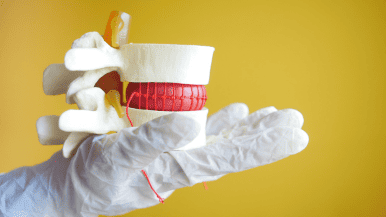 Are you experiencing a sharp pain that shoots down your leg, accompanied by discomfort in your lower back? You might be dealing with sciatica, a condition that’s not just any ordinary lower-body pain but a specific issue involving the sciatic nerve. This nerve stretches from your lower back, through your buttocks, down to your heel, and when it’s irritated, the discomfort can be significant.
Are you experiencing a sharp pain that shoots down your leg, accompanied by discomfort in your lower back? You might be dealing with sciatica, a condition that’s not just any ordinary lower-body pain but a specific issue involving the sciatic nerve. This nerve stretches from your lower back, through your buttocks, down to your heel, and when it’s irritated, the discomfort can be significant.
A leading cause of sciatica is a herniated disc, where the soft cushion between the spine’s vertebrae protrudes or ruptures, pressing on the sciatic nerve. It’s a common issue, with up to 40% of people experiencing sciatica at some point.
However, there are other reasons you might experience pain from sciatica. At Advanced Orthopaedic Center, we diagnose and treat sciatica every day and understand how debilitating it can be. Here is a look at the causes, symptoms, treatment, and other important answers to your sciatica questions.
What is Sciatica
Sciatica is more than just a simple backache. It’s a specific kind of pain from irritation or inflammation of the sciatic nerve, the longest nerve in your body. When something presses on or irritates this nerve, it can cause pain, numbness, or tingling radiating from your lower back down to your feet, but it usually affects just one side of your body.
Sciatica is different from regular back pain because it’s not limited to the back. The pain can travel along the path of the sciatic nerve, which means it can reach your hips, buttocks, legs, and even your feet. This can make sitting, standing, and even lying down uncomfortable, significantly affecting your daily activities.
Most people recover fully from sciatica and do not have ongoing leg pain or weakness. Others may experience chronic pain or weakness that doesn’t go away, in which case sciatica surgery, also known as microdiscectomy, may be necessary. About 86% of people experience pain relief after microdiscectomy.
Anatomy of the Sciatic Nerve
The sciatic nerve, the longest and widest in the body, plays a key role in connecting the spinal cord with the legs and feet. Here’s a simplified look at its path and why it’s often injured:
Path of Sciatic Nerve
 It begins in the lower back, travels through the buttocks, down the thighs, and branches into the feet.
It begins in the lower back, travels through the buttocks, down the thighs, and branches into the feet.
Several factors make the sciatic nerve prone to injury. Its long path through the body exposes it to potential harm at various points, from herniated discs in the lower back to constriction by the piriformis muscle in the buttocks.
Additionally, its proximity to the spine means spinal disorders, such as spinal stenosis or spondylolisthesis, can directly affect the nerve.
Lifestyle factors, including obesity and prolonged sitting, can also increase the risk of sciatic nerve compression.
Causes and Symptoms of Sciatica
Sciatica arises from various conditions that cause irritation or compression of the sciatic nerve. The leading culprits include:
- Herniated Discs: Discs that cushion the vertebrae of the spine can bulge or rupture, pressing on the sciatic nerve.
- Spinal Stenosis: Narrowing of the spinal canal can put pressure on the nerve roots, leading to the sciatic nerve.
- Piriformis Syndrome: If it spasms, the piriformis muscle in the buttocks near the top of the hip joint can irritate or pinch the sciatic nerve.
Herniated discs are the most common cause of sciatica, responsible for up to 90% of cases. Talking to a doctor can help diagnose what’s causing the problem, likely requiring an MRI of your lower back.
Symptoms of Sciatica
If you experience shooting pain from your back to your leg that causes weakness or an inability to walk without pain, you likely are experiencing sciatica. It’s best to consult with an orthopaedic doctor when you experience this type of pain.
Symptoms include:
- Pain radiates from the lower back to the buttock and down the back of the leg.
- Numbness, tingling, or muscle weakness in the affected leg or foot.
- Pain that worsens with movement; relief upon resting.
Diagnosing Sciatica
Accurate diagnosis of sciatica involves a combination of methods:
- Physical Examinations: Assessing pain response to movements and positions can help pinpoint sciatica.
- Medical Imaging: MRI scans are particularly useful for viewing the spine’s structure to identify the exact cause of nerve compression.
- Early Diagnosis: Recognizing sciatica early can significantly improve the effectiveness of treatment plans, preventing further nerve damage and pain.
Treatment Options for Sciatica
 Treatment for sciatica ranges from non-invasive to surgical options, depending on the severity.
Treatment for sciatica ranges from non-invasive to surgical options, depending on the severity.
Traditional Treatments
- Physical Therapy and Exercises: Strengthening the back, improving flexibility, and reducing pressure on the sciatic nerve.
- Medications: Pain relievers, anti-inflammatories, and muscle relaxants to alleviate pain and inflammation.
- Shots or Epidural Steroid Injections: Epidural injection are used to relieve herniated disc pain.
- Surgical Options: Considered when conservative treatments fail and the pain is severe, involving procedures to relieve nerve compression.
Surgery for Sciatica
Multiple surgical options exist for nerve compression. Here are a few that may be considered for helping long-term sciatica sufferers.
Microdiscectomy: A Preferred Option for Herniated Discs
A microdiscectomy is often recommended for sciatica resulting from a lumbar disc herniation. This procedure involves removing a portion of the disc material by pressing on the nerve root, sometimes along with a small section of bone. Despite being an open surgery, it’s performed with minimally invasive techniques, requiring only a small incision and causing minimal tissue damage. Studies suggest that up to 86% of patients report significant relief from sciatica pain following a microdiscectomy.
Lumbar Decompression Surgeries: Targeting Nerve Compression
Several surgical techniques aim to alleviate sciatica by addressing nerve root compression:
- Laminectomy: Designed to create more space for spinal nerves by removing all or part of the lamina. This surgery is particularly effective for sciatica caused by lumbar spinal stenosis, with 75% to 90% of patients experiencing pain relief.
- Foraminotomy: This surgery enlarges the neuroforamen, the opening through which nerve roots exit the spine, by removing bony overgrowths. It’s aimed at easing the pressure on the nerve roots.
- Facetectomy: A procedure to relieve nerve compression from degenerated facet joints involving the trimming, undercutting, or removing facet joints. An estimated 85% of patients find relief from sciatica pain after undergoing a facetectomy.
These surgical interventions are carefully considered when conservative treatments haven’t provided adequate relief, focusing on each patient’s specific cause of sciatica to optimize outcomes.
Alternative Treatments for Sciatica Pain
The treatment choice should be guided by a thorough diagnostic evaluation and discussion between the patient and doctor, considering each option’s potential benefits and risks.
- Acupuncture and Chiropractic Care: Some find relief through these methods, though effectiveness can vary.
- Massage Therapy: Can help relieve muscle spasms that contribute to sciatica pain.
Managing Sciatica Pain: Practical Tips
Alleviating sciatica pain starts by understanding the cause. Did your pain start from sitting in a chair all day at work? Did you hurt your back while lifting? Perhaps it was an injury that didn’t heal properly. To get long-term relief, it’s important to figure out the cause first and then adjust your lifestyle, including lumbar and back support or adding stretches before work.
Pain Relief Strategies:
- Over-the-counter Medications: NSAIDs (non-steroidal anti-inflammatory drugs) can help reduce inflammation and pain. Always follow the recommended dosage and consult with a healthcare provider if unsure.
- Topical Treatments: Creams and ointments designed for pain relief can also temporarily relieve sciatica discomfort.
Ice/Heat Therapy:
- Ice Packs: Applying ice packs to the affected area during the first 48 hours of pain flare-ups can help reduce inflammation.
- Heat Therapy: After 48 hours, switch to a heat pack to relax tight muscles and increase blood flow.
Stretches and Exercises for Relief:
- Gentle Stretching: Start with stretches that target the lower back, gluteal muscles, and hamstrings without exacerbating your pain.
- Strengthening Exercises: Focus on building strength in your core muscles to support your spine and reduce the strain on your sciatic nerve.
Modifying Daily Activities:
- Lifting Techniques: Lift heavy objects correctly, using your legs and keeping your back straight to avoid unnecessary strain.
- Taking Breaks: If your job involves sitting for prolonged periods, make it a point to stand, stretch, and walk around at regular intervals.
Ergonomic Adjustments:
- Workspace Ergonomics: Invest in a chair that offers lumbar support and adjust your workstation so that your monitor is at eye level and you’re not straining to reach your keyboard.
- Supportive Footwear: Wear shoes that provide adequate support, especially if you spend a lot of time on your feet.
Long-Term Management and Prevention
To prevent the recurrence of sciatica and maintain spinal health, consider these strategies:
- Nonsurgical: Epidural steroid injections (ESIs) are a common treatment option for many forms of lower back pain and leg pain. They are considered an integral part of the nonsurgical management of sciatica and lower back pain.
- Regular Exercise and Weight Management: A consistent exercise regimen that strengthens the core muscles can support your spine. Keeping within a healthy weight range reduces pressure on the sciatic nerve.
- Healthy Spine Tips: To maintain spinal alignment, practice good posture, choose supportive footwear, and sleep on a mattress that offers a balance of comfort and support.
FAQs About Sciatica
- Use a pillow between or under your knees to align your spine.
- Sleep on a firm mattress to support your back.
- Try sleeping on your side or back, avoiding sleeping on the stomach.
Many cases of sciatica can be resolved with physical therapy, lifestyle adjustments, and sometimes surgery. A complete cure depends on the underlying cause and severity of damage.
Orthopaedic surgeons and neurologists specialize in treating sciatica, and physical therapists also play a crucial role in managing and recovering it.
Epidural steroid injections for sciatica involve administering anti-inflammatory medication directly into the epidural space around the spinal nerves. This treatment aims to reduce pain and inflammation caused by nerve compression or irritation. Here’s a closer look at their effectiveness and duration:
- Effectiveness: Many patients experience significant relief from sciatica symptoms following an epidural steroid injection. The level of effectiveness can vary, with some patients reporting immediate improvement in symptoms.
Sciatica pain can range from a mild ache to a sharp, burning sensation or intense discomfort. It usually affects one side of the body, radiating from the lower back down through the leg.
Gentle stretches, such as the piriformis stretch, seated spinal twist, and hamstring stretches, can help relieve pressure on the sciatic nerve.
- Acute and Chronic Sciatica: Acute lasts for a short period, while chronic persists for more than three months.
- Bilateral Sciatica: Affects both legs.
- Lumbar Radiculopathy: Caused by compression of the lumbar nerves.
Lying on your back with a pillow under your knees or lying on your side with a pillow between your knees can relieve pressure on the sciatic nerve. Adjusting your position until you find relief is key.
Several surgical options are available for treating sciatica, especially when conservative treatments fail to provide relief. The choice of surgery depends on the underlying cause of sciatica. Common procedures include:
- Microdiscectomy: Primarily for herniated discs. It involves removing the portion of the disc that is pressing on the sciatic nerve.
- Laminectomy: This procedure, which is intended to relieve pressure caused by spinal stenosis, involves removing part of the vertebra (the lamina) to create more space for the nerves.
- Foraminotomy: This surgery widens the foramen, the opening in the spine through which the nerve roots exit, to reduce pressure on the nerve.
- Discectomy: Similar to a microdiscectomy, it may involve removing a larger portion of the disc.
Many sciatica surgeries, including microdiscectomy and foraminotomy, can be performed using minimally invasive techniques. These approaches typically involve:
- Smaller incisions lead to reduced muscle and tissue damage.
- Shorter hospital stays and recovery periods.
- Less postoperative pain and a reduced need for pain medication.
Minimally invasive surgery aims to achieve the same outcomes as traditional open surgery while minimizing the physical impact on the patient. However, the appropriateness of minimally invasive surgery depends on the specific circumstances of each case, including the cause of sciatica, the patient’s overall health, and the surgeon’s expertise.
When to Seek Professional Help
 If sciatica symptoms persist, leading to constant pain and lack of mobility or experiencing episodes of sciatica more often, you should seek professional help. Here are some tips:
If sciatica symptoms persist, leading to constant pain and lack of mobility or experiencing episodes of sciatica more often, you should seek professional help. Here are some tips:
Signs for Professional Intervention: If your sciatica pain persists beyond a few weeks, significantly worsens, or is accompanied by symptoms like weakness or loss of bladder or bowel control, seek medical advice.
Consult with an Orthopaedic Surgeon: Orthopaedic doctors at Advanced Orthopaedic Center can offer tailored advice and treatment options. They may recommend physical therapy, medications, or, in some cases, surgery. Expect a thorough evaluation, which could include imaging tests to determine the underlying cause of your sciatica pain.
Understanding sciatica is the first step toward effective management and treatment. While the condition can be painful and disruptive, many find relief through a combination of self-care, professional treatment, and lifestyle changes.
At Advanced Orthopaedic Center, we’re committed to providing you with the expertise and support you need to manage sciatica. Remember, with the right approach, you can live a full and active life despite sciatica.
Prioritize your spinal health through regular exercise, weight management, and ergonomic practices, and don’t hesitate to seek professional help when needed.



